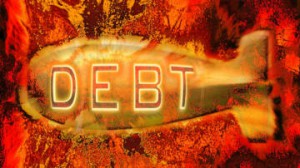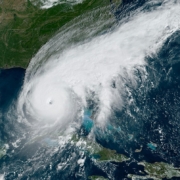Defusing the Debt Bomb
by James Johnston
 If it didn’t have such explosive consequences, you’d have to laugh at the comedy of errors unfolding in the U.S. political arena. Politicians are proposing farcical “solutions” to the debt crisis in a competition to see who is better at pandering to the electorate. Are citizens really supposed to believe that raising taxes, refinancing, or cutting expenditures will provide meaningful relief on ballooning bank-inherited interest payments — payments so stratospheric that the human mind lacks a conceptual reference point for them? Each and every government service could be cut and it still wouldn’t help pay off the debt. The problem can’t be solved by reining in an overgrown government bureaucracy because much of it was created by an unregulated, overgrown banking system.
If it didn’t have such explosive consequences, you’d have to laugh at the comedy of errors unfolding in the U.S. political arena. Politicians are proposing farcical “solutions” to the debt crisis in a competition to see who is better at pandering to the electorate. Are citizens really supposed to believe that raising taxes, refinancing, or cutting expenditures will provide meaningful relief on ballooning bank-inherited interest payments — payments so stratospheric that the human mind lacks a conceptual reference point for them? Each and every government service could be cut and it still wouldn’t help pay off the debt. The problem can’t be solved by reining in an overgrown government bureaucracy because much of it was created by an unregulated, overgrown banking system.
On the advice of conventional economic sages, we are to believe that the “credit crunch” is an event that took place in the past, with the words “growth” and “recovery” being used instead. But the transfer of debt from the private sector to the public sector in 2008 has merely postponed the inevitable detonation of a debt bomb that started ticking many years ago. If the government manages the bank-inherited debt in such preposterously piecemeal terms, it will never be paid off. Propping up the same broken banking system won’t solve the problem and will eventually cause history to repeat itself.
Only meaningful regulatory and monetary reform — reform that lowers the leverage ratio of lenders and discourages irresponsible gambling with the money earned by average people — can truly diffuse the debt bomb and prevent this from happening again. The result will increase the stability of the financial system and bring us closer to an economic steady state. But it means that we have to give up our collective obsession with the meaningless, self-destructive growth provided by an overgrown banking sector. First, government leaders must stop celebrating the growth of debt-inflated GDP figures like unthinking, euphoric addicts.
How we got here
No one can pinpoint the causes of the Great Depression with certainty, but prominent economist Irving Fisher argued that the predominant catalyst was over-indebtedness and speculation, which fuelled asset bubbles (Fisher, 1933). Sound familiar? After the Great Depression, the U.S. government initiated reforms based on Fischer’s explanation of the problem. The purpose was to avoid another debt-driven crisis. New regulations prevented bankers from speculating with depositors’ savings, and the U.S. economy experienced many years of prosperity without financial crisis. Investment banking was a more conservative endeavor and savings and loan funds were not used for speculation or risky business investing.
Fast-forward half a century. During the 1980s, the deregulation of banking allowed savings and loan banks to make increasingly risky bets with borrowers’ money. Some banks failed during the savings and loan crisis, yet the process of deregulation continued. Meanwhile, bankers’ wages skyrocketed. So-called new financial “products” facilitated speculation and fueled an illusion of growth and prosperity. The illusion enshrouded bankers in a mystical aura. Everything they touched turned to gold, and politicians and citizens began to regard them as sages. Only the most intelligent people, one might suppose, could create so much wealth so quickly.
 The illusion of growth produced illusions of stability and prosperity; bad decisions were rewarded while lessons from history were either disregarded or forgotten. In 2008, as the American economy inched uncomfortably close to detonation, the big banks revealed that the debt bomb was much larger than initially thought. Still the regulatory bomb squad sat idle. At no point did they come up with a useful plan for truly defusing it — it was simply postponed through the transference of debt. This occurred in spite of the risks associated with a pending disruption of the monetary system: the potential disappearance of savings, the foreclosure of homes, disruptions in the flow of goods and services, and unemployment. As a bomb counting down to detonation, here is the timeline we need to bear in mind:
The illusion of growth produced illusions of stability and prosperity; bad decisions were rewarded while lessons from history were either disregarded or forgotten. In 2008, as the American economy inched uncomfortably close to detonation, the big banks revealed that the debt bomb was much larger than initially thought. Still the regulatory bomb squad sat idle. At no point did they come up with a useful plan for truly defusing it — it was simply postponed through the transference of debt. This occurred in spite of the risks associated with a pending disruption of the monetary system: the potential disappearance of savings, the foreclosure of homes, disruptions in the flow of goods and services, and unemployment. As a bomb counting down to detonation, here is the timeline we need to bear in mind:
- At ten seconds to detonation, advances in computing technology allow for “bankers” (many of whom were in fact physicists and computer scientists) to create investment products called “derivatives,” products that Warren Buffet called “financial weapons of mass destruction.”
- At nine seconds, the financial sector consolidates into gigantic firms — something that was illegal following the Great Depression. Laws are changed under the guise of “modernization,” paving the path for the debt economy to balloon (and for history to repeat itself). Attempts to regulate derivatives fail and banking practices become increasingly risky.
- At eight seconds, the euphoria reaches new heights. Loans are used as a means of generating investment funds for large banks. It becomes harder to track the risk associated with certain kinds of debt, as they are lumped together into an untraceable electronic mass (including commercial and residential mortgages, car loans, student loans, credit card debt and corporate debt). The products — “collateralized debt obligations” or “CDOs” — are given high ratings by credit rating agencies.
- Seven seconds. Despite high ratings, many of the loans held in these portfolios are borrowed by people who cannot repay them. The banks don’t care, however, because insurance and default mechanisms allow them to avoid repaying any of the bad loans they issue. Besides, they argue, defaults like that are historically unprecedented.
- Six seconds. As dot-com stocks crash due to over-speculation, investment money flows into sub-prime mortgages, which become all the rage. Mortgages reach their highest prices in history and home values skyrocket around the country. Indeed, many countries around the world see home values spike faster than ever. In the process, big financial firms (including JP Morgan, Credit Suisse, Citibank, Freddie Mac/Fannie Mae and UBS) defraud their borrowers to push profits ever higher.
- Five seconds. The leverage ratio between borrowed money and reserve money reaches new heights (from 20:1 to 30:1). For every dollar a bank has, it loans out 20 to 30 times that amount. Limits on leverage are relaxed, enabling banks to bet more with the money of depositors.
- Four seconds. U.S. home prices double over their 1986 levels. The IMF and a handful of economists warn of crisis.
- Three seconds. Big firms declare bankruptcy and the giant debt bureaucracy (the big banks) take a tumble.
- Two seconds. As if covering a bomb in duct-tape, the U.S. government bails out the banks and transfers debt from the private sector to the public sector, tripling U.S. debt overnight. And yet, the same system that caused the crisis is propped up.
At this point in history, with the debt reaching more than 14 trillion dollars, U.S. leadership has a choice between defusing the bomb with meaningful regulatory and monetary reform — reform that lowers the leverage ratio and punishes irresponsible institutional gambling — or further bandaging a broken system that meaninglessly consumes government expenditures and cripples the real economy to the benefit of big banks. Choosing the latter will again postpone the inevitable, maintaining an unstable economic status-quo obsessed with illusory growth derived from debt-inflated GDP.
If the U.S. government refuses to defuse the bomb now, it will explode in the foreseeable future as risky banking practices continue and interest payments (penalties for past mistakes) soar to super-stratospheric heights. The irresponsible actions of financially bloated bankers are being overlooked by a government distracted with irrelevant ideological arguments. When the debt bomb finally detonates, those responsible will likely avoid the fallout in the comfort of their unjustifiable excess. And while average people can try to shield themselves by minimizing their exposure to the debt-inflated growth economy, they will undoubtedly suffer the most. If only those elected to represent their interests would overcome petty illusions and turn their attention to more critical reforms than cutting and taxing.




I don’t get it. Mr. Johnson starts and ends with concern about the federal government’s debt and then presents a well put story counting down to the U.S. financial system’s meltdown in 2008. These are two different stories and different sets of debt. The only figured mentioned is the federal debt of $14 trillion dollars. Unmentioned is the non-governmental debt load that actually led up to the 2008 crisis. That debt was in the form of mortgage lending, personal consumer debt, business debt, and financial sector debt. Taken together, non-governmental debt, at its peak, was twice the size of the government’s current debt. U.S. societal debt, private and public, has reached a historic high of three times the GDP.
Economic growth is an issue of grave global concern and I am a wholehearted supporter of CASSE and the need for a steady state economy. However, the role of debt financing within the instituted structure of modern capitalism must be adequately and clearly understood. Capitalist economic growth dynamics, a dynamics intimately grounded in money and banking, ought to thoroughly explored by CASSE. Most 20th century economists who explored finance capitalism adhered to a strong economic growth perspective. I hope that doesn’t rule such economists as Keynes or Minsky as being out of bounds by steady state thinkers. Otherwise we’ll easily miss important features of what exactly drives this crazy system of irrational and unsustainable growth.
You’re absolutely right that consumer debt is the number one debt problem. Minsky and Keen provide some fascinating and useful thoughts on consumer debt (and asset prices in particular), and perhaps we can address this subject more directly in a later post.
What I’m trying to make clear here is exactly the point you make: the government debt problem we are witnessing is a systemic issue that transcends government taxing and spending. The issue is in fact connected to the consumer debt problem (facilitated by easy access to credit and other risky banking practices) and indeed, the monetary system itself.
The figures used to refer to the debt problem are often misleading and unhelpful, because there is debt held “on-balance-sheet” debt and “off-balance-sheet” (not to mention the various bailout commitments that have not yet been spent, a number that the NY Times added up to 12.2 trillion as recently as July 24th. See http://www.nytimes.com/interactive/2009/02/04/business/20090205-bailout-totals-graphic.html). The number quoted in this post is the ubiquitous one found in the media, referring to “on-balance-sheet” debt.
To paint perhaps a more useful picture, between 2009 and 2010 alone, the Federal Reserve bought at least $1.7 worth of mortgage-backed securities, creating new money specifically for that purpose. The banks were the recipients. No matter what figure is cited, the purchase of mortgage-backed securities has been a tremendous drain on government expenditures to the benefit of those who played perhaps the greatest role in creating the problem. The government bailout of the banks has added up to trillions and yet the risky system remains.
It was very refreshing to read your review of the basic historic steps that lead to the 2008 crisis. The detailed historical accounts of those steps, such as the law with modernization in the title, I was able to track down through one or more William Greider articles for the Nation magazine, and his reference to Peter Goodman of the New York Times. Other journalists and contributors to the NY Times have made an enlightening collection and detailed accounting of the influence of economic ideology and business practices on political legislating.
Nevertheless, it is also important to keep abreast of alternative practices in these discussions to help illuminate the problem of the ideological practices. At least two come to my mind. First, the co-operative banks of Europe may have been less impacted, and following the crisis were able to respond through their own mutual assistance.
Secondly, the US credit unions similarly were somewhat insulated, a subject treated well by Ralph Nader in an article for Counterpunch.
Dave Korten has also been writing about the problem of the prevailing market behaviors, and at one point was using Smith and Ricardo´s own theoretical assumptions to critique contemporary capitalist market manipulation.
While I am a supporter of CASSE and the ecological component of the steady state logic, I am strongly conscientious about the social component. William Greider and Mark Lutz have both written interesting works including both Herman Daly´s ideas and David Ellerman´s ideas of the labor theory of economic property.
Also worth noting are the alternative economic models which exist such as the European-Japanese stakeholder models, even though they have to a large degree been subjected to the demands of the shareholder model.
I was just reminded of the ILO report on the general resilience of co-ops in the crisis. It is a 2009 report at their website.
The 2000 Commodity Futures Modernization Act opened the channels for banks to create derivatives around mortgage related securities, as reported by D. Leonhardt in the NY Times in 2008. He introduces this information by discussing at some length a prior bill, the Gramm-Leach-Bliley Act of 1999 which undid the essential order created by the Glass-Steagall Act of the New Deal years. I would say this is pretty essential information to understand the economic underpinnings of political decisions and legislation, and the consequences of corporate executives´behavior and the market outcomes.
(D. Leonhardt, “Reconsideration: Washington’s Invisible Hand,” The New York Times, Sept. 26, 2008)
What I find most disconcerting is the speed and willingness with which S&P moved to downgrade the States compared to the way they looked the other way for years leading up to and during the credit crunch. It suggests they were on one agenda then and a different one now – but what? Is this evidence of the ‘banker wars’ rumours that are floating around?